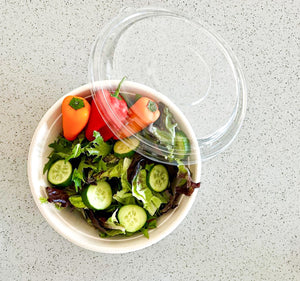Is your business carbon friendly?

Do you know that 53 cases of 10-inch Cornware 100% biodegradable plates save enough CO2 as electricity to power the average UK home for one whole year?
There is substantial evidence that climate change is man-made and to mitigate this, majority of countries have put in place plans to reduce the levels of ‘greenhouse gases’ being released into the atmosphere. These gases, especially carbon dioxide have been responsible for global warming. So reducing CO2 emissions will definitely go a long way to helping the environment.
To reduce CO2 emissions, we need to first measure our carbon footprints. It can be calculated for a product, service, person or even a country, and is used to understand the impact human activity is having on the earth’s climate. The standard unit of measurement for carbon footprints is carbon dioxide equivalents (CO2e). And though CO2e combines the measurement of six types of greenhouse gasses, namely carbon dioxide (CO2), methane (CH4), nitrous oxide (N2O), perfluorocarbons (PFC), hydrofluorocarbons (HFC) and sulphur hexafluoride (SF6), carbon dioxide is the most important greenhouse gas.
For a business to be carbon friendly, it needs to first know which activities within its operations and value chain generate CO2 emissions in order to measure its corporate carbon footprint. There are always many options available in the production processes, energy usage, transportation modes, supply chain, packaging and even marketing, for a business to consider and choose more sustainable choices.
In fact, in the UK large corporations have to include full information about their carbon emissions in their annual reports.
Element UK is eco-friendly business as evident from its carbon friendly 100% biodegradable tableware.
Here are some facts about Element products’ carbon footprints.
- The process of making Element is 72% more carbon efficient than traditional plastics. Element is:
- 72% more carbon efficient than when compared to polystyrene;
- 67% more carbon efficient than when compared to polyethylene Terephthalate (PET)
- 55% more carbon efficient than when compared to LDPE
- 52% more carbon efficient than when compared to polypropylene (PP)
- 51% more carbon efficient than when compared to HDPE
- 48% more carbon efficient than when compared to LLDPE
- 1kg of plastic emits 3.4kg of CO2 when incinerated compared to 1.14 kg of CO2 emissions when Element is burnt.
- 27 cases of Element lunch boxes saves a whooping 1,400 kg of CO2 = the weight of one beluga whale
- Carbon neutrality of Element
- Element, a bioplastic is made from Origo – primarily corn and yam starch.
- The quantity of carbon dioxide released when incinerated is up to 68% less than conventional plastics.
- To illustrate -
- A corn plant takes in carbon dioxide from the atmosphere as it grows.
- 1 unit of the carbon dioxide is “stored” in the corn.
- This corn, together with the 1 unit of carbon dioxide, is made into Element.
- When Element is incinerated, the same 1 unit of carbon dioxide is released back into the atmosphere
- The net amount of carbon dioxide in the atmosphere has not increased.
- In addition, no toxic gases will be released during burning and the ash that is produced is non-toxic. It will not cause land and water pollution when they are eventually dumped in a landfill.
- Plastics, on the other hand, releases new carbon dioxide into the atmosphere when burnt, contributing to the greenhouse gases.
- Element products not only have smaller carbon footprints to plastics, they also predominantly come from renewable sources of material that will biodegrade and not be a burden on society.
A food could use 3 times the number of Element tableware as opposed to equivalent plastic products and still have a smaller carbon footprint.




